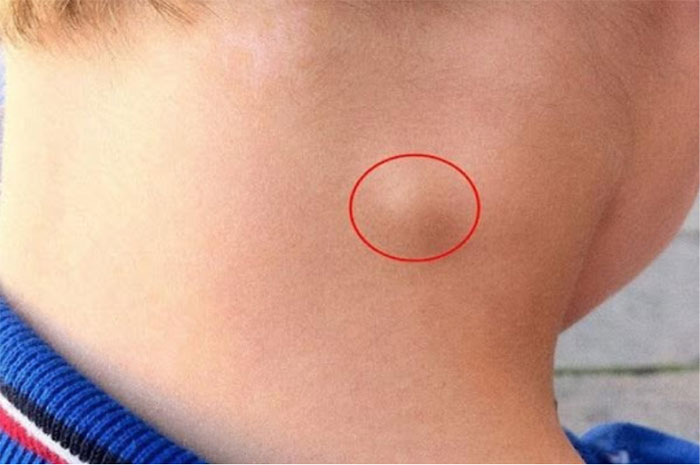Swollen lymph nodes (also known as lymphadenitis) is an infection of the lymph nodes in the body’s lymphatic system. When the body is infected or ill, it produces more immune cells. The increase in these cells leads to swelling of the lymph nodes. Therefore, this condition is also considered a sign of an infection or pathology.
Swollen Lymph Nodes: Causes, Symptoms, and Treatment
What is lymphadenitis?
Swollen lymph nodes usually occur due to infections from bacteria or viruses. Rarely, swollen lymph nodes may be due to cancer.
Lymph nodes, also known as lymph glands, play a crucial role in your body’s ability to fight infections. These lymph nodes are part of the immune system, producing antibodies that help combat the invasion of foreign substances (viruses, bacteria). When attacked by foreign invaders, the lymph nodes become inflamed, resulting in lymphadenitis. Common areas where you may notice swollen lymph nodes include the neck, under the chin, armpits, and groin.
Lymphadenitis is a manifestation of various infectious causes such as bacteria, viruses, fungi, and protozoa. Localized lymphadenitis is primarily seen in infections such as Streptococcus, tuberculosis, or non-tuberculous Mycobacteria infections, tularemia, plague, cat scratch disease, primary syphilis, lymphogranuloma venereum, chancroid, and genital herpes. Generalized lymphadenitis is common in:
- Infectious mononucleosis.
- Cytomegalovirus infection.
- Toxoplasmosis.
- Brucellosis.
- Secondary syphilis.
- Disseminated histoplasmosis.
Signs and Symptoms of Lymphadenitis
Lymphadenitis typically presents with symptoms such as pain, increased sensitivity, and enlarged lymph nodes. When a specific area is inflamed, a swollen, painful lump often indicates lymphadenitis compared to other lymph node diseases. In some bacterial infections, the surrounding skin may become inflamed, sometimes accompanied by cellulitis, and occasionally fever. An abscess may form, possibly invading the skin and creating fistulas.

Lymphadenitis typically presents with symptoms such as pain, increased sensitivity, and enlarged lymph nodes.
Depending on the cause of the swollen lymph nodes, other signs and symptoms you may experience include:
Runny nose, sore throat, fever, and other signs of upper respiratory infection.
Generalized swelling of lymph nodes throughout the body. When this occurs, it may indicate an infection, such as HIV or mononucleosis, or an immune system disorder, such as lupus or rheumatoid arthritis.
- Hard, fixed, rapidly growing nodes, indicating a possibility of cancer or lymphoma.
- Fever.
- Night sweats.
Possible Complications of Lymphadenitis
If an infection is the cause of swollen lymph nodes and is left untreated, an abscess may form. An abscess is a localized collection of pus due to infection. Pus contains fluid, white blood cells, dead tissue, and bacteria or other invaders. An abscess may require drainage and antibiotic treatment.
Causes of Lymphadenitis
Lymph nodes are small, round or bean-shaped clusters of cells. Inside the lymph nodes are a mixture of different types of immune system cells. These specialized cells filter your lymph fluid as it travels through the body and protect you by destroying invaders.
Lymph nodes are grouped, and each group drains a specific area of your body. You may easily notice swelling in certain areas, such as the lymph nodes in the neck, under the chin, armpits, and groin. The location of the swollen lymph nodes may help identify the underlying cause.
The most common cause of swollen lymph nodes is infection, especially viral infections, such as the common cold. Other causes that may lead to swollen lymph nodes include:
- Common infections.
- Streptococcal pharyngitis.
- Measles.
- Ear infections.
- Infected teeth (abscess).
- Mononucleosis.
- Skin infections or wounds, such as cellulitis.
- Human Immunodeficiency Virus (HIV) – the virus that causes AIDS.
Individuals at Risk of Lymphadenitis
Uncommon Infections:
- Tuberculosis.
- Some sexually transmitted infections, such as syphilis.
Toxoplasmosis – a parasitic infection from exposure to feces of infected cats or eating undercooked meat. - Cat scratch fever – a bacterial infection caused by cat scratches or bites.
Immune System Disorders:
- Lupus – a chronic inflammatory disease targeting your joints, skin, kidneys, blood cells, heart, and lungs.
Rheumatoid arthritis – a chronic inflammatory disease targeting the lining of your joints (synovium).
Cancer:
- Lymphoma – cancer originating from your lymphatic system.
- Leukemia – cancer of your body’s blood-forming tissues, including bone marrow and lymphatic system.
- Other cancers that have spread (metastasized) to the lymph nodes.
Testing and Diagnosing Lymphadenitis
- Clinical evaluation.
- Culture or biopsy may sometimes be necessary.
Diagnosis may involve taking a history and performing a clinical examination. If necessary, fluid aspiration and culture or biopsy will be ordered.
To diagnose what may be causing your swollen lymph nodes, your doctor may need:
- Your medical history: The doctor will want to know when and how your swollen lymph nodes developed and if you have any other signs or symptoms.
- A physical examination: The doctor will also want to examine the lymph nodes near the surface of your skin for size, tenderness, warmth, and texture. The location of the swollen lymph nodes and your other signs and symptoms will provide clues to the underlying cause.
- Blood tests: Some blood tests can help confirm or rule out any suspected underlying conditions. Specific tests will depend on the suspected cause but will likely include a complete blood count (CBC). This test helps assess your overall health and detect a range of disorders, including infections and leukemia.
- Imaging studies: A chest X-ray or computed tomography (CT) scan of the affected area may help identify potential sources of infection or locate tumors.
- Lymph node biopsy: Your doctor may request a biopsy to ensure an accurate diagnosis. They will take a sample from a lymph node or even an entire lymph node for microscopic examination.
Effective Treatment Methods for Lymphadenitis
Depending on the patient’s condition and the severity of the illness, the doctor will prescribe medications and apply appropriate treatment methods.
Treatment targets the underlying cause of the disease and is based on experience. Options include intravenous antibiotics, antifungal medications, and antiparasitic treatments depending on the suspected cause or clinical symptoms. Many patients with lymphadenitis may respond to outpatient treatment with oral antibiotics. However, many patients continue to develop abscesses, requiring extensive incision and drainage along with intravenous antibiotics. In children, intravenous antibiotics are necessary. Warm compresses may help relieve pain.
Lymphadenitis generally responds well to timely treatment, although swollen, persistent, asymptomatic lymph nodes are common.
Swollen lymph nodes due to viral infections typically return to normal after the viral infection resolves. Antibiotics are not helpful for treating viral infections. Treatment for swollen lymph nodes due to other causes depends on the underlying cause:
- Infection: The most common treatment method for swollen lymph nodes due to bacterial infection is antibiotics. If the swollen lymph nodes are due to HIV infection, you will receive specific treatment for that condition.
- Immune Disorders: If the swollen lymph nodes are a result of certain conditions, such as lupus or rheumatoid arthritis, treatment will be directed at the underlying condition.
- Cancer: Swollen lymph nodes due to cancer require cancer treatment. Depending on the type of cancer, treatment may include surgery, radiation therapy, or chemotherapy.
Note: Medications should be taken according to your doctor’s guidance.
Lifestyle Habits to Help Manage Lymphadenitis
Lifestyle Recommendations:
- Follow your doctor’s instructions regarding treatment.
- Maintain an active lifestyle and reduce stress.
- Contact your doctor immediately if you notice any abnormalities during treatment.
- Schedule regular check-ups to monitor your health status, disease progression, and to allow your doctor to find suitable treatment options if the condition shows no signs of improvement.
- Stay optimistic. Your mental state greatly affects treatment; talk to trusted individuals, share with family members, care for pets, or simply read books and do anything that makes you feel comfortable.
- Apply a warm compress. Use a warm, damp cloth, such as a washcloth soaked in hot water, and place it on the affected area.
- Get plenty of rest.
- Gargle with salt water. If the swollen lymph nodes are located in the neck, ears, jaw, or head, you should gargle with salt dissolved in warm water. Gargle for about 10 – 20 seconds, then spit out the water. Repeat 3 – 5 times a day.
Effective Prevention Methods for Lymphadenitis
To effectively prevent the disease, you can refer to the following suggestions:
- Maintain personal hygiene.
- Eat a healthy diet and exercise to improve your health.
- Seek medical attention immediately if you notice signs of infection or swollen painful lumps under the skin.
- Clean any scratches or wounds on the skin.
What Does a Swollen Lymph Node on the Left Side of the Neck Indicate?

















































